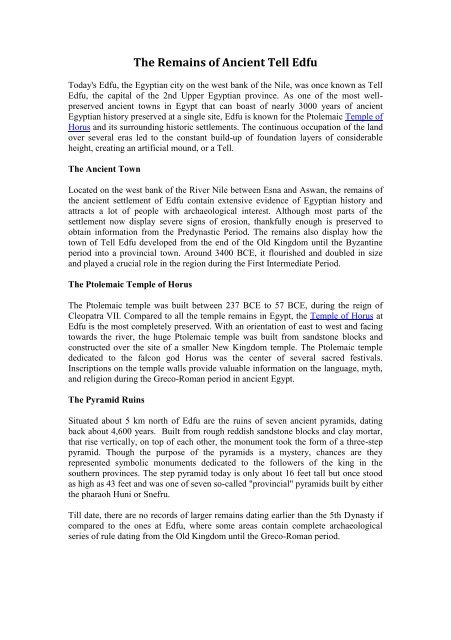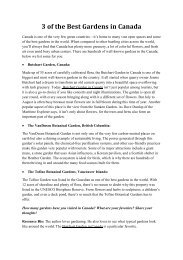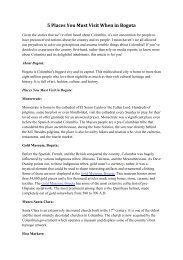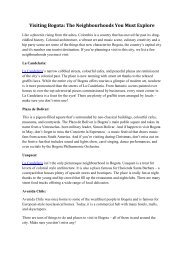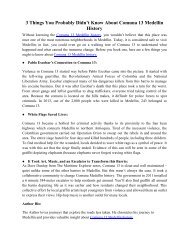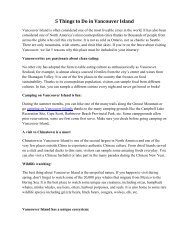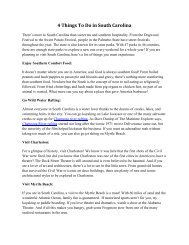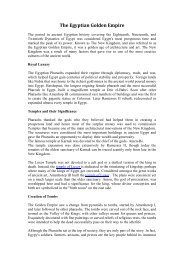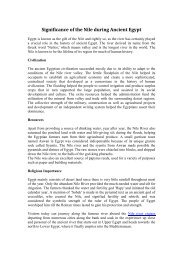The Remains of Ancient Tell Edfu
Today's Edfu, the Egyptian city on the west bank of the Nile, was once known as Tell Edfu, the capital of the 2nd Upper Egyptian province. Visit http://themaritimeexplorer.ca/2017/07/17/edfu-luxor-part-ii-nile-cruise-loved/ to learn more.
Today's Edfu, the Egyptian city on the west bank of the Nile, was once known as Tell Edfu, the capital of the 2nd Upper Egyptian province. Visit http://themaritimeexplorer.ca/2017/07/17/edfu-luxor-part-ii-nile-cruise-loved/ to learn more.
You also want an ePaper? Increase the reach of your titles
YUMPU automatically turns print PDFs into web optimized ePapers that Google loves.
<strong>The</strong> <strong>Remains</strong> <strong>of</strong> <strong>Ancient</strong> <strong>Tell</strong> <strong>Edfu</strong><br />
Today's <strong>Edfu</strong>, the Egyptian city on the west bank <strong>of</strong> the Nile, was once known as <strong>Tell</strong><br />
<strong>Edfu</strong>, the capital <strong>of</strong> the 2nd Upper Egyptian province. As one <strong>of</strong> the most wellpreserved<br />
ancient towns in Egypt that can boast <strong>of</strong> nearly 3000 years <strong>of</strong> ancient<br />
Egyptian history preserved at a single site, <strong>Edfu</strong> is known for the Ptolemaic Temple <strong>of</strong><br />
Horus and its surrounding historic settlements. <strong>The</strong> continuous occupation <strong>of</strong> the land<br />
over several eras led to the constant build-up <strong>of</strong> foundation layers <strong>of</strong> considerable<br />
height, creating an artificial mound, or a <strong>Tell</strong>.<br />
<strong>The</strong> <strong>Ancient</strong> Town<br />
Located on the west bank <strong>of</strong> the River Nile between Esna and Aswan, the remains <strong>of</strong><br />
the ancient settlement <strong>of</strong> <strong>Edfu</strong> contain extensive evidence <strong>of</strong> Egyptian history and<br />
attracts a lot <strong>of</strong> people with archaeological interest. Although most parts <strong>of</strong> the<br />
settlement now display severe signs <strong>of</strong> erosion, thankfully enough is preserved to<br />
obtain information from the Predynastic Period. <strong>The</strong> remains also display how the<br />
town <strong>of</strong> <strong>Tell</strong> <strong>Edfu</strong> developed from the end <strong>of</strong> the Old Kingdom until the Byzantine<br />
period into a provincial town. Around 3400 BCE, it flourished and doubled in size<br />
and played a crucial role in the region during the First Intermediate Period.<br />
<strong>The</strong> Ptolemaic Temple <strong>of</strong> Horus<br />
<strong>The</strong> Ptolemaic temple was built between 237 BCE to 57 BCE, during the reign <strong>of</strong><br />
Cleopatra VII. Compared to all the temple remains in Egypt, the Temple <strong>of</strong> Horus at<br />
<strong>Edfu</strong> is the most completely preserved. With an orientation <strong>of</strong> east to west and facing<br />
towards the river, the huge Ptolemaic temple was built from sandstone blocks and<br />
constructed over the site <strong>of</strong> a smaller New Kingdom temple. <strong>The</strong> Ptolemaic temple<br />
dedicated to the falcon god Horus was the center <strong>of</strong> several sacred festivals.<br />
Inscriptions on the temple walls provide valuable information on the language, myth,<br />
and religion during the Greco-Roman period in ancient Egypt.<br />
<strong>The</strong> Pyramid Ruins<br />
Situated about 5 km north <strong>of</strong> <strong>Edfu</strong> are the ruins <strong>of</strong> seven ancient pyramids, dating<br />
back about 4,600 years. Built from rough reddish sandstone blocks and clay mortar,<br />
that rise vertically, on top <strong>of</strong> each other, the monument took the form <strong>of</strong> a three-step<br />
pyramid. Though the purpose <strong>of</strong> the pyramids is a mystery, chances are they<br />
represented symbolic monuments dedicated to the followers <strong>of</strong> the king in the<br />
southern provinces. <strong>The</strong> step pyramid today is only about 16 feet tall but once stood<br />
as high as 43 feet and was one <strong>of</strong> seven so-called "provincial" pyramids built by either<br />
the pharaoh Huni or Snefru.<br />
Till date, there are no records <strong>of</strong> larger remains dating earlier than the 5th Dynasty if<br />
compared to the ones at <strong>Edfu</strong>, where some areas contain complete archaeological<br />
series <strong>of</strong> rule dating from the Old Kingdom until the Greco-Roman period.
Author Bio: <strong>The</strong> author is a long-time writer and has a keen fascination towards the<br />
rise and fall <strong>of</strong> ancient civilizations. <strong>The</strong> Temple <strong>of</strong> Horus and the ancient ruins at<br />
<strong>Edfu</strong> have been his latest interest.


